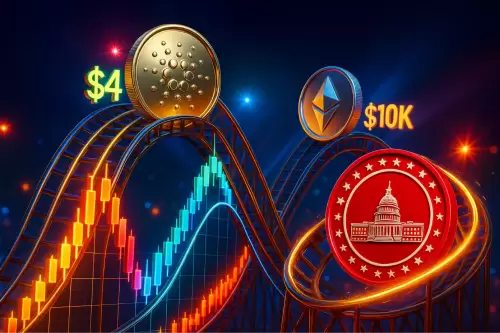 |
|
 |
|
 |
|
 |
|
 |
|
 |
|
 |
|
 |
|
 |
|
 |
|
 |
|
 |
|
 |
|
 |
|
 |
|

The price of Polkadot (CRYPTO:DOT) cryptocurrency has risen by 51.3% from April 9 to May 12.
While this is a noteworthy gain, it pales in comparison to the coin's 52.6% decline from December's 52-week peak. Moreover, the coin is trading at more than 90% below Polkadot's all-time highs, which were reached just before the inflation panic began in November 2021.
Is Polkadot stuck in a long-term downtrend, or is this crucial Web3 component poised for a big comeback?
Polkadot's Bull Case
In a Web3 world, social media networks will play a less dominant role online.
Content creators will have greater control over the text, music, movies, and other media they produce, with fewer intermediaries skimming a portion of the original content. Ordinary people will enjoy more direct control over how they consume content, safeguard their privacy, and manage personal finances. Again, everything will operate faster, with lower fees, and blockchain-based technology will perform tasks currently handled by centralized banks.
Polkadot was designed to play several critical roles in this conversion of online interaction systems. It features a complex and powerful transaction ledger with many supporting data lists, capable of communicating with numerous other blockchain systems. The upcoming Polkadot 2.0 version will introduce a much faster and more complete facility for executing smart contracts. In recent demonstrations, Polkadot co-founder Gavin Wood showed the classic Doom game running at full speed on a pre-release version of this JAM virtual machine system, operating on his laptop. The full implementation will have access to thousands of high-powered server systems in a global network.
I can only imagine what developers might create with this blockchain-based supercomputer. This should be more than sufficient to launch the Web3 revolution and take it to new heights. That would be welcome news for Polkadot investors, as the functional coin is expected to gain more value with increased real-world usage.
Why Polkadot Could Struggle
Some early Polkadot investors are losing hope regarding the proposed Web3 revolution.
The vision for Web3 has been in the works for over a decade. Gavin Wood coined the term in 2014, but the fundamental ideas had been under discussion for years before that. In the rapidly evolving world of technology, that's a vast amount of time. Where are all the game-changing Web3 apps and platforms that will transform the online landscape?
And assuming the Web3 revolution does materialize, Polkadot faces fierce competition in powering the technical platforms behind those privacy-focused apps. To put it in perspective, Sony brought the first Betamax video tapes to market a year ahead of JVC's VHS alternative, and Betamax had the backing of Japan's regulators at the time. However, VHS won the "video wars" of the 1970s. The favored industry standard doesn't always prevail in the open market. In this instance, alternative development frameworks from Solana (CRYPTO: SOL) or Avalanche (CRYPTO: AVAX) could steal Polkadot's Web3 throne. If they can't replicate every Polkadot function today, their backers could catch up as their ecosystems mature.
With the slow rollout of Web3 and the rising tide of potential head-to-head rivals, it's no surprise to see Polkadot's coin price floundering.
What Is This Coin Really Worth?
Pinning fair values on investments is both an art and a science. Getting it right involves several assumptions, some informed guesswork, and a bit of luck. The world's best investors don't get every call right, and they rarely try to set exact price targets for the long term.
And Polkadot's market value depends on two key factors:
The first component has been slow to take off. Few apps are built around the Polkadot framework today, and the cryptocurrency is still in its early stages from the real-world usage perspective. Daily usage volumes have been declining in recent months. In the last 30 days, Polkadot fees averaged $750 per day. There aren't many money-generating transactions happening yet. The JAM-based Polkadot 2.0 system is designed to handle 1 million transactions per second, not a couple of hundred per day.
The daily trading volume is much higher, at around $360 million per 24 hours. In other words, Polkadot is acting more like a speculative investment than a real-world business tool so far. The coin is essentially worthless in this real-world utility perspective. Polkadot usage just isn't a money-making operation yet.
But that's a short-sighted projection. I'm convinced that the Web3 era will come someday. Will it be during the next economic recession, with the launch of the first truly useful decentralized finance app
免責聲明:info@kdj.com
所提供的資訊並非交易建議。 kDJ.com對任何基於本文提供的資訊進行的投資不承擔任何責任。加密貨幣波動性較大,建議您充分研究後謹慎投資!
如果您認為本網站使用的內容侵犯了您的版權,請立即聯絡我們(info@kdj.com),我們將及時刪除。
-

- 比特幣,美聯儲稅率和加密貨幣:紐約人的拍攝
- 2025-08-05 13:23:49
- 導航加密貨幣嗡嗡聲:比特幣的彈性,稅率降低了耳語以及加密貨幣的興起。在這個財務前沿獲取內部勺子。
-

-

-

-

- 花式農場野餐:在2026年美國眾議院比賽中偷看
- 2025-08-05 08:04:52
- 肯塔基州的幻想農場野餐為2026年的美國眾議院提供了一個舞台,適應不斷發展的政治景觀,並提出了早期開始競選季節的信號。
-

-

-

-






























































